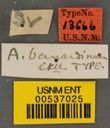Woolcarder Bees
Anthidium
Classification
- Phylum: Arthropoda
- Subphylum: Hexapoda
- Class: Insecta
- Order: Hymenoptera
- Family: Megachilidae
- Subfamily: Megachilinae
- Tribe: Anthidiini
- Genus: Anthidium
Pronunciation
How to pronounce Anthidium: //ænˈθɪdiəm//
These audio files are automatically generated. While they are not always 100% accurate, they are a good starting point.
Images






Summary
Anthidium is a cosmopolitan genus of solitary bees known for their unique nesting behaviors and distinctive physical characteristics, including size dimorphism and specialized nesting materials. The genus plays an essential role in pollination and includes both extant and fossil species.
Physical Characteristics
Typically characterized by abdominal bands that are usually interrupted in the middle and without a lobe (arolium) between their claws. Males have three 'thorns' at their abdominal apex used for territorial defense.
Identification Tips
Males are larger than females, with lengths averaging 18 mm for males and 12 mm for females. Look for distinct yellow or brick-red thoracic bands in species such as Anthidium florentinum.
Habitat
Nests in holes in the ground, walls, or trees, often utilizing plant hairs, earth, or conifer resin to construct their nests.
Distribution
Widespread across North America and much of the world, except Australasia and Southeast Asia. Common in eastern North America, particularly species like A. manicatum and A. oblongatum, which are adventive species of European origin.
Diet
Feeds their brood on pollen and nectar, primarily from various plants.
Life Cycle
Active from May to September, with specific seasonal activity such as July to August in Minnesota.
Reproduction
Females collect down from pubescent plants to line their nests, which are typically constructed solitary. Mating often occurs before nesting.
Ecosystem Role
As solitary pollinators, they play a critical role in the pollination of various plants, contributing to the ecosystems in which they exist.
Economic Impact
Some species may be important for agricultural pollination, though exact economic impacts remain under-studied.
Collecting Methods
- Netting adults during flight
- Using bee traps with fragrant baits
Preservation Methods
- Ethanol preservation
- Pinned specimens
Evolution
The genus has been classified under family Megachilidae with a cosmopolitan distribution, comprising both extant and fossil species that date back to the Priabonian to Rupelian deposits.
Misconceptions
Often confused with honey bees, but Anthidium species are solitary and do not produce honey.
Tags
- bees
- Megachilidae
- pollinators
- solitary bees